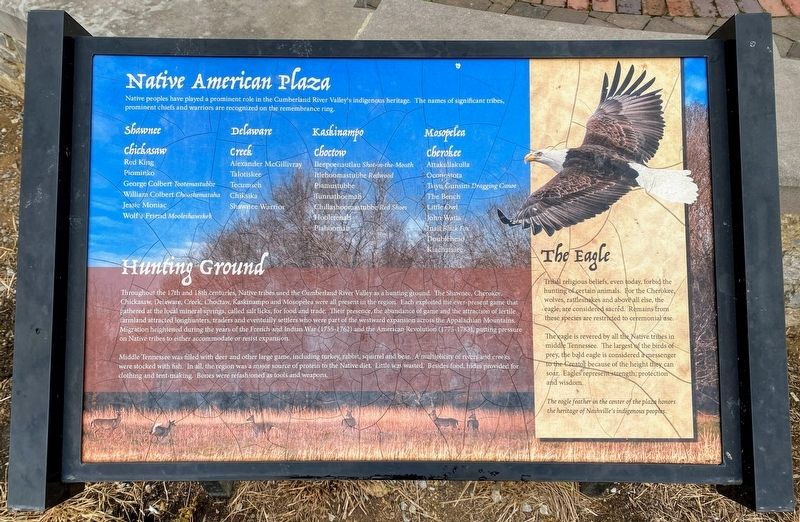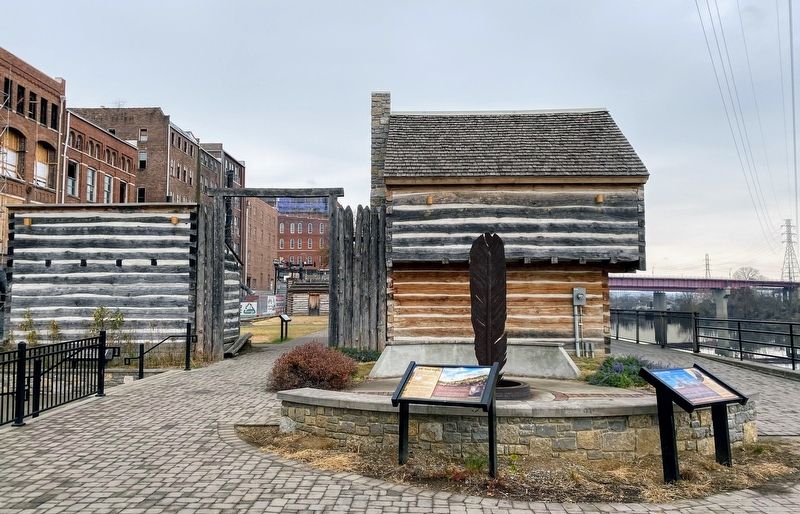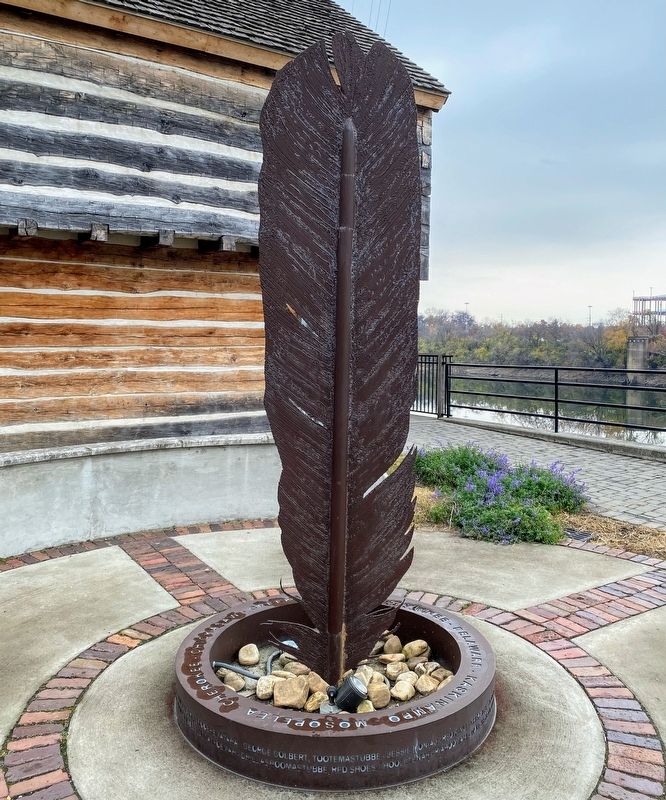Downtown in Nashville in Davidson County, Tennessee — The American South (East South Central)
Native American Plaza
Shawnee • Delaware • Kaskinampo • Mosopelea
Chickasaw
Red King
Piominko
George Colbert Tootemastubbe
William Colbert Chooshemataha
Jessie Moniac
Wolf's Friend Mooleshawskek
Creek
Alexander McGillivray
Talotiskee
Tecumseh
Chiksika
Shawnee Warrior
Choctow
Ileepoenautlau Shot-in-the-Mouth
Itlehoomastubbe Redwood
Piamustubbe
Tunnathoemah Chillashoomastubbe Red Shoes
Hooletenah
Piahoomah
Cherokee
Attakullakulla
Oconostota
Tsiyu
Gunsini Dragging Canoe
The Bench
Little Owl
John Walts
Inali Black Fox
Doublehead
Kiachatalee
Hunting Ground
Throughout the 17th and 18th centuries, Native tribes used the Cumberland River Valley as a hunting ground. The Shawnee, Cherokee, Chickasaw, Delaware, Creek, Choctaw, Kaskinampo and Mosopelea were all present in the region. Each exploited the ever-present game that gathered at the local mineral springs, called salt licks, for food and trade. Their presence, the abundance of game and the attraction of fertile farmland attracted longhunters, traders and eventually settlers who were part of the westward expansion across the Appalachian Mountains. Migration heightened during the years of the French and Indian War (1755-1762) and the American Revolution (1775-1783), putting pressure on Native tribes to either accommodate or resist expansion.
Middle Tennessee was filled with deer and other large game, including turkey, rabbit, squirrel and bear. A multiplicity of rivers and reeks were stocked with fish. In all, the region was a major source of protein to the Native diet. Little was wasted. Besides food, hides provided for clothing and tent-making. Bones were refashioned as tools and weapons.
The Eagle
Tribal religious beliefs, even today, forbid the hunting of certain animals. For the Cherokee, wolves, rattlesnakes and above all else, the eagle, are considered sacred. Remains from these species are restricted to ceremonial use.
The eagle is revered by all the Native tribes in middle Tennessee. The largest of the birds of prey, the bald eagle is considered a messenger to the Creator because of the height they can
soar. Eagles represent strength, protection, and wisdom.
Erected 2017 by Metro Parks Nashville.
Topics. This historical marker is listed in these topic lists: Native Americans • Settlements & Settlers.
Location. 36° 9.843′ N, 86° 46.514′ W. Marker is in Nashville, Tennessee, in Davidson County. It is in Downtown. Marker is on 1st Avenue North, 0.1 miles north of Broadway (U.S. 70), on the right when traveling north. Located on the grounds of the reconstructed Fort Nashborough, at the Native American history plaza near the fort's southern entrance. Touch for map. Marker is at or near this postal address: 170 1st Ave N, Nashville TN 37201, United States of America. Touch for directions.
Other nearby markers. At least 8 other markers are within walking distance of this marker. The First Peoples (here, next to this marker); Colonel John Donelson (a few steps from this marker); River Cane (a few steps from this marker); The Bluff Station (a few steps from this marker); Fort Nashborough (within shouting distance of this marker); The Cumberland Settlements (within shouting distance of this marker); The Cumberland Compact (within shouting distance of this marker); Colonel Richard Henderson (within shouting distance of this marker). Touch for a list and map of all markers in Nashville.
More about this marker. In 2015,
the previous Fort Nashborough reproduction was torn down and rebuilt. The new Fort Nashborough replica opened in 2017, with new interpretive markers. As of 2021, none of the buildings at the reproduction fort are open, and thus a visit to Fort Nashborough simply entails viewing a few historical markers and the exterior of a few log buildings.
Credits. This page was last revised on February 7, 2023. It was originally submitted on December 24, 2021, by Shane Oliver of Richmond, Virginia. This page has been viewed 310 times since then and 39 times this year. Photos: 1, 2, 3. submitted on December 24, 2021, by Shane Oliver of Richmond, Virginia. • Mark Hilton was the editor who published this page.


